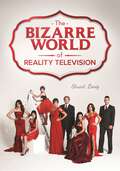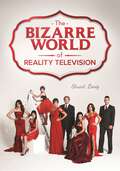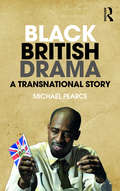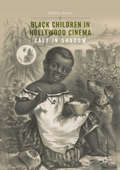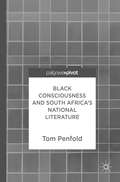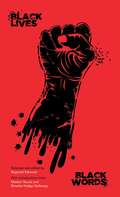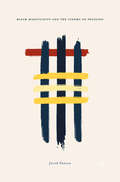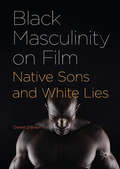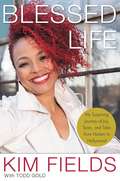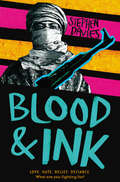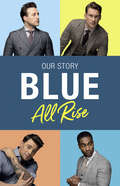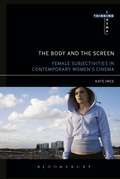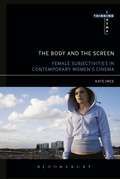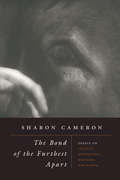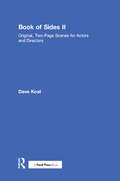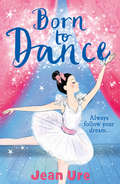- Table View
- List View
The Bizarre World of Reality Television
by Stuart LenigHow do reality television programs shape our view of the world and what we perceive as real and normal? This book explores the bizarre and highly controversial world of reality television, including its early history, wide variety of subject matter, and social implications.In recent decades, reality television shows ranging from Keeping up with the Kardashians to Duck Dynasty have become increasingly popular. Why are these "unscripted" programs irresistible to millions of viewers? And what does the nearly universal success of reality shows say about American culture? This book covers more than 100 major and influential reality programs past and present, discussing the origins and past of reality programming, the contemporary social and economic conditions that led to the rise of reality shows, and the ways in which the most successful shows achieve popularity with both male and female demographics or appeal to specific, targeted niche audiences.The text addresses reality TV within five, easy-to-identify content categories: competition shows, relationship/love-interest shows, real people or alternative lifestyle and culture shows, transformation shows, and international programming. By examining modern reality television, a topic of great interest for a wide variety of readers, this book also discusses cultural and social norms in the United States, including materialism, unrealistic beauty ideals, gender roles and stereotypes in society, dynamics of personal relationships, teenage lifestyles and issues, and the branding of people for financial gain and wider viewership.
The Bizarre World of Reality Television
by Stuart LenigHow do reality television programs shape our view of the world and what we perceive as real and normal? This book explores the bizarre and highly controversial world of reality television, including its early history, wide variety of subject matter, and social implications.In recent decades, reality television shows ranging from Keeping up with the Kardashians to Duck Dynasty have become increasingly popular. Why are these "unscripted" programs irresistible to millions of viewers? And what does the nearly universal success of reality shows say about American culture? This book covers more than 100 major and influential reality programs past and present, discussing the origins and past of reality programming, the contemporary social and economic conditions that led to the rise of reality shows, and the ways in which the most successful shows achieve popularity with both male and female demographics or appeal to specific, targeted niche audiences.The text addresses reality TV within five, easy-to-identify content categories: competition shows, relationship/love-interest shows, real people or alternative lifestyle and culture shows, transformation shows, and international programming. By examining modern reality television, a topic of great interest for a wide variety of readers, this book also discusses cultural and social norms in the United States, including materialism, unrealistic beauty ideals, gender roles and stereotypes in society, dynamics of personal relationships, teenage lifestyles and issues, and the branding of people for financial gain and wider viewership.
Black British Drama: A Transnational Story
by Michael PearceBlack British Drama: A Transnational Story looks afresh at the ways black theatre in Britain is connected to and informed by the spaces of Africa, the Caribbean and the USA. Michael Pearce offers an exciting new approach to reading modern and contemporary black British drama, examining plays by a range of writers including Michael Abbensetts, Mustapha Matura, Caryl Phillips, Winsome Pinnock, Kwame Kwei-Armah, debbie tucker green, Roy Williams and Bola Agbaje. Chapters combine historical documentation and discussion with close analysis to provide an in-depth, absorbing account of post-war black British drama situated within global and transnational circuits. A significant contribution to black British and black diaspora theatre studies, Black British Drama is a must-read for scholars and students in this evolving field.
Black British Drama: A Transnational Story
by Michael PearceBlack British Drama: A Transnational Story looks afresh at the ways black theatre in Britain is connected to and informed by the spaces of Africa, the Caribbean and the USA. Michael Pearce offers an exciting new approach to reading modern and contemporary black British drama, examining plays by a range of writers including Michael Abbensetts, Mustapha Matura, Caryl Phillips, Winsome Pinnock, Kwame Kwei-Armah, debbie tucker green, Roy Williams and Bola Agbaje. Chapters combine historical documentation and discussion with close analysis to provide an in-depth, absorbing account of post-war black British drama situated within global and transnational circuits. A significant contribution to black British and black diaspora theatre studies, Black British Drama is a must-read for scholars and students in this evolving field.
Black Children in Hollywood Cinema: Cast in Shadow
by Debbie OlsonThis book explores cultural conceptions of the child and the cinematic absence of black children from contemporary Hollywood film. Debbie Olson argues that within the discourse of children’s studies and film scholarship in relation to the conception of “the child,” there is often little to no distinction among children by race—the “child” is most often discussed as a universal entity, as the embodiment of all things not adult, not (sexually) corrupt. Discussions about children of color among scholars often take place within contexts such as crime, drugs, urbanization, poverty, or lack of education that tend to reinforce historically stereotypical beliefs about African Americans. Olson looks at historical conceptions of childhood within scholarly discourse, the child character in popular film and what space the black child (both African and African American) occupies within that ideal.
Black Children in Hollywood Cinema: Cast in Shadow
by Debbie OlsonThis book explores cultural conceptions of the child and the cinematic absence of black children from contemporary Hollywood film. Debbie Olson argues that within the discourse of children’s studies and film scholarship in relation to the conception of “the child,” there is often little to no distinction among children by race—the “child” is most often discussed as a universal entity, as the embodiment of all things not adult, not (sexually) corrupt. Discussions about children of color among scholars often take place within contexts such as crime, drugs, urbanization, poverty, or lack of education that tend to reinforce historically stereotypical beliefs about African Americans. Olson looks at historical conceptions of childhood within scholarly discourse, the child character in popular film and what space the black child (both African and African American) occupies within that ideal.
Black Consciousness and South Africa’s National Literature
by Tom PenfoldThis book analyses Black Consciousness poetry and theatre from the 1970s through to the present. South Africa’s literature, like its history, has been beset by disagreement and contradiction, and has been consistently difficult to pin down as one, united entity. Much existing criticism on South Africa’s national literature has attempted to overcome these divisions by discussing material written from a variety of different subject positions together. This book argues that Black Consciousness desired a new South Africa where African and European cultures were valued equally, and writers could represent both as they wished. Thus, a body of literature was created that addressed a range of audiences and imagined the South African nation in different ways. This book explores Black Consciousness in order to demonstrate how South African writers have responded in various ways to the changing history and politics of their country.
Black Consciousness and South Africa’s National Literature
by Tom PenfoldThis book analyses Black Consciousness poetry and theatre from the 1970s through to the present. South Africa’s literature, like its history, has been beset by disagreement and contradiction, and has been consistently difficult to pin down as one, united entity. Much existing criticism on South Africa’s national literature has attempted to overcome these divisions by discussing material written from a variety of different subject positions together. This book argues that Black Consciousness desired a new South Africa where African and European cultures were valued equally, and writers could represent both as they wished. Thus, a body of literature was created that addressed a range of audiences and imagined the South African nation in different ways. This book explores Black Consciousness in order to demonstrate how South African writers have responded in various ways to the changing history and politics of their country.
Black Lives, Black Words: 32 Short Plays (Oberon Modern Playwrights)
by Reginald EdmundDo Black Lives Matter? Selected and edited by the award winning American playwright Reginald Edmund, who produced Black Lives, Black Words across the US, which premiered in Chicago, July 2015. The international project has explored the black diaspora’s experiences in some of the largest multicultural cities in the world, Chicago, Minneapolis, Cleveland, Toronto and London. Over sixty Black writers from the UK, USA, and Canada have each written a short play to address Black issues today. Featured in this collection are: Reginald Edmund, Idris Goodwin, James Austin, Williams, Rachel Dubose, Becca C. Browne, Marsha Estell, Aaron Holland, Loy A. Webb, Lisa Langford, Christina Ham, Harrison David Rivers, Dominique Morisseau, Winsome Pinnock, Trish Cooke, Mojisola Adebayo, Rachel De-Lahay, Max Kolaru, Yolanda Mercy, Somalia Seaton, Courttia Newland, Luke Reece, Tawiah BenEben, M’Carthy Kanika Ambrose. Jordan Laffrenier. Meghan Swaby. Mary Ann Anane. Allie Woodson. Elliot Sagay. Amira Danan. Cat Davidson. Noelle Fourte and Kori Alston
Black Masculinity and the Cinema of Policing (PDF)
by Jared SextonThis book offers a critical survey of film and media representations of black masculinity in the early twenty-first-century United States, between President George W. Bush’s 2001 announcement of the War on Terror and President Barack Obama’s 2009 acceptance of the Nobel Peace Prize. It argues that images of black masculine authority have become increasingly important to the legitimization of contemporary policing and its leading role in the maintenance of an antiblack social order forged by racial slavery and segregation. It examines a constellation of film and television productions—from Antoine Fuqua’s Training Day to John Lee Hancock’s The Blind Side to Barry Jenkin's Moonlight—to illuminate the contradictory dynamics at work in attempts to reconcile the promotion of black male patriarchal empowerment and the preservation of gendered antiblackness within political and popular culture.
Black Masculinity on Film: Native Sons and White Lies
by Daniel O'BrienThis book provides wide-ranging commentary on depictions of the black male in mainstream cinema. O’Brien explores the extent to which counter-representations of black masculinity have been achieved within a predominately white industry, with an emphasis on agency, the negotiation and malleability of racial status, and the inherent instability of imposed racial categories. Focusing on American and European cinema, the chapters highlight actors (Woody Strode, Noble Johnson, Eddie Anderson, Will Smith), genres (jungle pictures, westerns, science fiction) and franchises (Tarzan, James Bond) underrepresented in previous critical and scholarly commentary in the field. The author argues that although the characters and performances generated in these areas invoke popular genre types, they display complexity, diversity and ambiguity, exhibiting aspects that are positive, progressive and subversive. This book will appeal to both the academic and the general reader interested in film, race, gender and colonial issues.
Blessed Life: My Surprising Journey of Joy, Tears, and Tales from Harlem to Hollywood
by Kim FieldsFrom "Facts of Life" to "Living Single" to "Dancing with the Stars" to wife and mom, here's the BLESSED LIFE of Kim Fields, veteran actress, TV personality, and star. Kim Fields has lived most of her life with people thinking they know her, which is understandable. From her first job on a Mrs. Butterworth syrup commercial at age 7, she has spent 40 years in the public eye. There were 9 years as Dorothy "Tootie" Ramsey on the classic sitcom The Facts of Life, 5 more in her 20s starring as Regine Hunter on the seminal coming-of-age show Living Single, and most recently appearing as herself on Real Housewives of Atlanta and Dancing with the Stars. Behind the camera, she has directed episodes of Kenan & Kel, Tyler Perry's Meet the Browns and House of Payne, and BET's Let's Stay Together. Between gigs, the pop culture icon's life has included theater, spoken word, music, speaking engagements, and simply being present to the point that she cannot go a day without someone stopping her to say, "When I was a kid, I wanted to be Tootie" or "You were my role model." Flattered and blessed, after four decades in the business, Kim finally understands the role she has played onscreen and off as a successful, outspoken African-American woman. However, for as much as she's been in the public eye, people have really never known her the way they think they have, and that's because she, herself, spent most of her life figuring herself out. Now, at age 48, she is ready to set the record straight. She says, "It's not that I've been misunderstood. It's that I finally feel like I understand me enough to tell the life story that I've been asked to write for years." It will be a chronicle of living, learning, and keen moments of self-discovery as she's journeyed through the many facets and chapters of life. Fields found faith at age 14 and has found God to be right there every step of the way since then.
Blood & Ink
by Stephen DaviesKadija is the music-loving daughter of a guardian of the sacred manuscripts of the ancient city of Timbuktu, Mali.Ali is a former shepherd boy, trained as a warrior for Allah.Tonight, the Islamist rebels are coming for Timbuktu. They will install a harsh regime of law and tear apart the peaceful world within the mud walls of the city. Television, football, radios, even music, will be banned. Kadija refuses to let go of her former life. And something in her defiance draws Ali to her.Which path will he choose?
Blue: Our Story
by Antony Costa Duncan James Lee Ryan Simon WebbeFor the first time, more than 15 years after four boys from London were first thrown together to form what would go on to become one of the most successful and infamous groups of the boyband era, Lee, Antony, Duncan and Simon tell their full, no-holds-barred story in their own inimitable words.
The Body and the Screen: Female Subjectivities in Contemporary Women’s Cinema (Thinking Cinema)
by Kate InceWinner of the British Association of Film, Television and Screen Studies Best Book Prize 2018Since the 1980s the number of women regularly directing films has increased significantly in most Western countries; in France, Claire Denis and Catherine Breillat have joined Agnès Varda in gaining international renown, while British directors Lynne Ramsay and Andrea Arnold have forged award-winning careers in feature film. This new volume in the "Thinking Cinema†? series draws on feminist philosophers and theorists from Simone de Beauvoir on to offer readings of a range of the most important and memorable of these films from the 1990s and 2000s, focusing as it does so on how the films convey women's lives and identities. Mainstream entertainment cinema traditionally distorts the representation of women, objectifying their bodies, minimizing their agency, and avoiding the most important questions about how cinema can "do justice" to female subjectivity. Kate Ince suggests that the films of independent women directors are progressively redressing the balance, reinvigorating both the narratives and the formal ambitions of European cinema. Ince uses feminist philosophers to interpret such films as Sex Is Comedy, Morvern Callar, White Material, and Fish Tank anew, suggesting that a philosophical understanding of female subjectivity as embodied and ethical should underpin future feminist film study.
The Body and the Screen: Female Subjectivities in Contemporary Women’s Cinema (Thinking Cinema)
by Kate InceWinner of the British Association of Film, Television and Screen Studies Best Book Prize 2018Since the 1980s the number of women regularly directing films has increased significantly in most Western countries; in France, Claire Denis and Catherine Breillat have joined Agnès Varda in gaining international renown, while British directors Lynne Ramsay and Andrea Arnold have forged award-winning careers in feature film. This new volume in the “Thinking Cinema” series draws on feminist philosophers and theorists from Simone de Beauvoir on to offer readings of a range of the most important and memorable of these films from the 1990s and 2000s, focusing as it does so on how the films convey women's lives and identities. Mainstream entertainment cinema traditionally distorts the representation of women, objectifying their bodies, minimizing their agency, and avoiding the most important questions about how cinema can "do justice" to female subjectivity. Kate Ince suggests that the films of independent women directors are progressively redressing the balance, reinvigorating both the narratives and the formal ambitions of European cinema. Ince uses feminist philosophers to interpret such films as Sex Is Comedy, Morvern Callar, White Material, and Fish Tank anew, suggesting that a philosophical understanding of female subjectivity as embodied and ethical should underpin future feminist film study.
The Bond of the Furthest Apart: Essays on Tolstoy, Dostoevsky, Bresson, and Kafka
by Sharon CameronIn the French filmmaker Robert Bresson’s cinematography, the linkage of fragmented, dissimilar images challenges our assumption that we know either what things are in themselves or the infinite ways in which they are entangled. The “bond” of Sharon Cameron’s title refers to the astonishing connections found both within Bresson’s films and across literary works by Tolstoy, Dostoevsky, and Kafka, whose visionary rethinkings of experience are akin to Bresson’s in their resistance to all forms of abstraction and classification that segregate aspects of reality. Whether exploring Bresson’s efforts to reassess the limits of human reason and will, Dostoevsky’s subversions of Christian conventions, Tolstoy’s incompatible beliefs about death, or Kafka’s focus on creatures neither human nor animal, Cameron illuminates how the repeated juxtaposition of disparate, even antithetical, phenomena carves out new approaches to defining the essence of being, one where the very nature of fixed categories is brought into question. An innovative look at a classic French auteur and three giants of European literature, The Bond of the Furthest Apart will interest scholars of literature, film, ethics, aesthetics, and anyone drawn to an experimental venture in critical thought.
The Bond of the Furthest Apart: Essays on Tolstoy, Dostoevsky, Bresson, and Kafka
by Sharon CameronIn the French filmmaker Robert Bresson’s cinematography, the linkage of fragmented, dissimilar images challenges our assumption that we know either what things are in themselves or the infinite ways in which they are entangled. The “bond” of Sharon Cameron’s title refers to the astonishing connections found both within Bresson’s films and across literary works by Tolstoy, Dostoevsky, and Kafka, whose visionary rethinkings of experience are akin to Bresson’s in their resistance to all forms of abstraction and classification that segregate aspects of reality. Whether exploring Bresson’s efforts to reassess the limits of human reason and will, Dostoevsky’s subversions of Christian conventions, Tolstoy’s incompatible beliefs about death, or Kafka’s focus on creatures neither human nor animal, Cameron illuminates how the repeated juxtaposition of disparate, even antithetical, phenomena carves out new approaches to defining the essence of being, one where the very nature of fixed categories is brought into question. An innovative look at a classic French auteur and three giants of European literature, The Bond of the Furthest Apart will interest scholars of literature, film, ethics, aesthetics, and anyone drawn to an experimental venture in critical thought.
The Bond of the Furthest Apart: Essays on Tolstoy, Dostoevsky, Bresson, and Kafka
by Sharon CameronIn the French filmmaker Robert Bresson’s cinematography, the linkage of fragmented, dissimilar images challenges our assumption that we know either what things are in themselves or the infinite ways in which they are entangled. The “bond” of Sharon Cameron’s title refers to the astonishing connections found both within Bresson’s films and across literary works by Tolstoy, Dostoevsky, and Kafka, whose visionary rethinkings of experience are akin to Bresson’s in their resistance to all forms of abstraction and classification that segregate aspects of reality. Whether exploring Bresson’s efforts to reassess the limits of human reason and will, Dostoevsky’s subversions of Christian conventions, Tolstoy’s incompatible beliefs about death, or Kafka’s focus on creatures neither human nor animal, Cameron illuminates how the repeated juxtaposition of disparate, even antithetical, phenomena carves out new approaches to defining the essence of being, one where the very nature of fixed categories is brought into question. An innovative look at a classic French auteur and three giants of European literature, The Bond of the Furthest Apart will interest scholars of literature, film, ethics, aesthetics, and anyone drawn to an experimental venture in critical thought.
The Bond of the Furthest Apart: Essays on Tolstoy, Dostoevsky, Bresson, and Kafka
by Sharon CameronIn the French filmmaker Robert Bresson’s cinematography, the linkage of fragmented, dissimilar images challenges our assumption that we know either what things are in themselves or the infinite ways in which they are entangled. The “bond” of Sharon Cameron’s title refers to the astonishing connections found both within Bresson’s films and across literary works by Tolstoy, Dostoevsky, and Kafka, whose visionary rethinkings of experience are akin to Bresson’s in their resistance to all forms of abstraction and classification that segregate aspects of reality. Whether exploring Bresson’s efforts to reassess the limits of human reason and will, Dostoevsky’s subversions of Christian conventions, Tolstoy’s incompatible beliefs about death, or Kafka’s focus on creatures neither human nor animal, Cameron illuminates how the repeated juxtaposition of disparate, even antithetical, phenomena carves out new approaches to defining the essence of being, one where the very nature of fixed categories is brought into question. An innovative look at a classic French auteur and three giants of European literature, The Bond of the Furthest Apart will interest scholars of literature, film, ethics, aesthetics, and anyone drawn to an experimental venture in critical thought.
The Bond of the Furthest Apart: Essays on Tolstoy, Dostoevsky, Bresson, and Kafka
by Sharon CameronIn the French filmmaker Robert Bresson’s cinematography, the linkage of fragmented, dissimilar images challenges our assumption that we know either what things are in themselves or the infinite ways in which they are entangled. The “bond” of Sharon Cameron’s title refers to the astonishing connections found both within Bresson’s films and across literary works by Tolstoy, Dostoevsky, and Kafka, whose visionary rethinkings of experience are akin to Bresson’s in their resistance to all forms of abstraction and classification that segregate aspects of reality. Whether exploring Bresson’s efforts to reassess the limits of human reason and will, Dostoevsky’s subversions of Christian conventions, Tolstoy’s incompatible beliefs about death, or Kafka’s focus on creatures neither human nor animal, Cameron illuminates how the repeated juxtaposition of disparate, even antithetical, phenomena carves out new approaches to defining the essence of being, one where the very nature of fixed categories is brought into question. An innovative look at a classic French auteur and three giants of European literature, The Bond of the Furthest Apart will interest scholars of literature, film, ethics, aesthetics, and anyone drawn to an experimental venture in critical thought.
The Bond of the Furthest Apart: Essays on Tolstoy, Dostoevsky, Bresson, and Kafka
by Sharon CameronIn the French filmmaker Robert Bresson’s cinematography, the linkage of fragmented, dissimilar images challenges our assumption that we know either what things are in themselves or the infinite ways in which they are entangled. The “bond” of Sharon Cameron’s title refers to the astonishing connections found both within Bresson’s films and across literary works by Tolstoy, Dostoevsky, and Kafka, whose visionary rethinkings of experience are akin to Bresson’s in their resistance to all forms of abstraction and classification that segregate aspects of reality. Whether exploring Bresson’s efforts to reassess the limits of human reason and will, Dostoevsky’s subversions of Christian conventions, Tolstoy’s incompatible beliefs about death, or Kafka’s focus on creatures neither human nor animal, Cameron illuminates how the repeated juxtaposition of disparate, even antithetical, phenomena carves out new approaches to defining the essence of being, one where the very nature of fixed categories is brought into question. An innovative look at a classic French auteur and three giants of European literature, The Bond of the Furthest Apart will interest scholars of literature, film, ethics, aesthetics, and anyone drawn to an experimental venture in critical thought.
Book of Sides II: Original, Two-Page Scenes for Actors and Directors
by Dave KostBook of Sides II: Original, Two-Page Scenes for Actors and Directors is the second book in the Book of Sides series by Dave Kost, featuring original, two-page, two-character scenes for use in acting, directing, and auditioning classes. While shorter than the traditional three-to-six-page scenes commonly used in classes, Book of Sides II features longer scenes than the first Book of Sides with greater character development, more reversals, and stronger climaxes. Balanced, structured scenes designed specifically for educational use challenge both actors and directors equally with objectives, obstacles, tactics, and subtext; Two-page length is ideal for high-intensity exercises and faster-paced workshops; Printed in easy-to-read film-script format with plenty of room for notes; Scenes are completely original and unencumbered by copyright, so students may film and post legally on the internet; Universally castable, so all roles can be played by actors of any gender, appearance, skill level, or ethnicity; Accessibly-written for modern students, helping them to focus on the fundamentals of performance and directing; Simple and conducive to performing in a classroom without sets, costumes, or special props. This book was written by an educator for educators and designed for use in the classroom. Never search for scenes again!
Book of Sides II: Original, Two-Page Scenes for Actors and Directors
by Dave KostBook of Sides II: Original, Two-Page Scenes for Actors and Directors is the second book in the Book of Sides series by Dave Kost, featuring original, two-page, two-character scenes for use in acting, directing, and auditioning classes. While shorter than the traditional three-to-six-page scenes commonly used in classes, Book of Sides II features longer scenes than the first Book of Sides with greater character development, more reversals, and stronger climaxes. Balanced, structured scenes designed specifically for educational use challenge both actors and directors equally with objectives, obstacles, tactics, and subtext; Two-page length is ideal for high-intensity exercises and faster-paced workshops; Printed in easy-to-read film-script format with plenty of room for notes; Scenes are completely original and unencumbered by copyright, so students may film and post legally on the internet; Universally castable, so all roles can be played by actors of any gender, appearance, skill level, or ethnicity; Accessibly-written for modern students, helping them to focus on the fundamentals of performance and directing; Simple and conducive to performing in a classroom without sets, costumes, or special props. This book was written by an educator for educators and designed for use in the classroom. Never search for scenes again!
Born to Dance (Dance Trilogy #1)
by Jean UreThe first in a brand-new series about dancing, friendship and following your dreams from best-loved author Jean Ure, whose books are described by Jacqueline Wilson as “funny, funky, feisty - and fantastic reads!”
